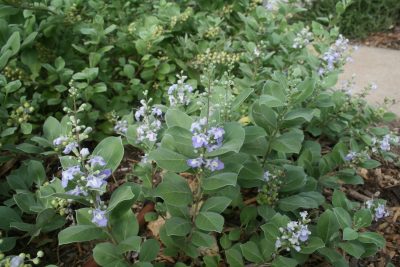Beach Vitex
Vitex Rotundifolia

If you do an internet search for this plant, the first thing that you’ll see is that it is considered an invasive species on the eastern coast of the US. But there’s no need to worry here in Central Texas. Beach vitex does spread quite nicely, but it will not become invasive in your landscape. But I would not suggest against planting it along any waterway or in any natural areas.
Beach vitex gets about a foot and half tall and can spread 3 feet or more wide. It loves the full sun and laughs at the heat. Although native to coastal areas, we’ve found that ours at Travis County Extension thrives on once-a-week watering in our sandy loam soil.
Beach vitex will be most happy in a mulched bed with some moisture in the air around it, rather than in a dry, rocky area of the landscape. If you have it planted in an area that is very well-drained and the soil doesn’t hold much moisture, you will need to water it more often.
The lovely grayish green oval leaves are accentuated by the purplish blue flower stems that cover the plant throughout the summer. Those flowers produce lots of seed heads that you can collect if you’d like to propagate it for other areas of your yard.
It makes a great groundcover and fills in very quickly. It also needs very little maintenance once established, not even pruning off the seed heads, since they’re so attractive.
Beach vitex is deciduous and does get a little woody as it gets older. And it does benefit from a light shearing in late winter, before the new leaves come out.
categories:
tags:
